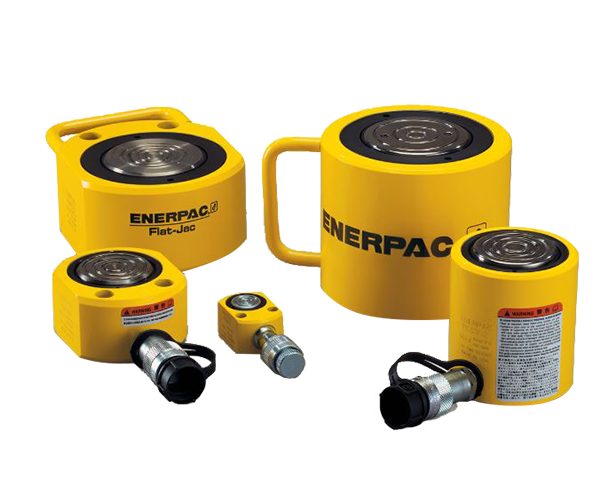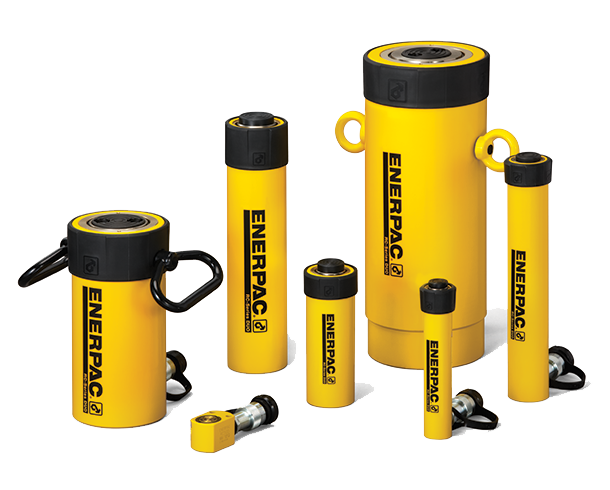Hydraulic Cylinders: Single Acting Cylinder vs Double Acting Cylinder
Hydraulic cylinders, often referred to as jacks or rams, are components in a hydraulic system that are responsible for movement. As such, they are usually seen as the “muscle” of a hydraulic system that performs push and pull movements. The movement comes from the pressure that is generated in a hydraulic system. This is usually from a pump that is connected to one of the ports on the hydraulic cylinder. A pressurised hydraulic fluid, such as hydraulic oil, is pumped into the cylinder which then extends the pistons.
There are two main hydraulic cylinder mechanisms; single acting and double acting. To help you decide which type of hydraulic cylinder is best for your application, we’ll be comparing a single acting cylinder vs double acting cylinder.
Single Acting Cylinders
A single acting hydraulic cylinder, also known as a single acting hydraulic ram, operates in a single direction. It typically has a single port at the bottom of the cylinder where pressurised fluid is pumped into the system. As the fluid enters the system, it fills the cylinder and extends the piston inside.
To retract the piston, a single acting hydraulic cylinder must rely on an external force to expunge the fluid inside. This can be left to gravity if there is no immediate need to retract the piston, but a second piston can also be used to forcefully push the piston back into the cylinder. Springs can also be used if they are strong enough.
Double Acting Cylinders
Double acting means the cylinder has two ports. These are typically located at the bottom and the top of the cylinder. Fluid is pumped into the bottom port to extend the piston much like a regular single acting cylinder.
But when the operator wants to retract the piston, fluid is pumped through the top port to push it back. This allows for more control of the system, but it can also be used for rapid retraction and extension. A double acting hydraulic ram can be used for push and pull configurations, but it can also be used for punching motions or opening and closing gates

Advantages of Single Acting Cylinders
Single acting cylinders are simpler and typically serve straightforward purposes. Since there are fewer components involved, this makes it a lot easier to maintain a single acting cylinder and they are generally considered to be more reliable due to fewer points of failure. It’s also possible to purchase single acting cylinders that have a lower profile, making them perfect for situations where space is at a premium, or if the force requirements are fairly low.
In short, a single acting cylinder is great for simple jobs, especially when the system or operator doesn’t require the retraction to be controlled or fast. If there is an external weight that will help retract the plunger, then a single acting cylinder is ideal.
Disadvantages of Single Acting Cylinders
Single acting cylinders suffer when it comes to retraction. If a system requires the retraction to be fast or controlled, then a single acting cylinder doesn’t have the capabilities to do this unless there is another single acting cylinder on the opposite side. However, it can be more costly both in terms of price and space to use two separate single acting cylinders instead of just a single double acting cylinder.
So if precise or fast retraction is needed, it’s recommended to use double acting cylinders instead.
Advantages of Double Acting Cylinders
Since double acting cylinders have two ports for hydraulic fluid, it allows for much more precise and faster retraction control. This is great for applications where a mechanism needs to be opened and closed, or if finer control is needed for highly specific or precise applications. Double acting cylinders also have hollow plunger and high tonnage variants much like single acting cylinders. When combined with the controlled and faster retraction speed, this opens up the possibility for many unique applications that can both save space and money.
The strength of a double acting cylinder is in its ability to quickly retract, or if the application calls for precise and controlled retraction.
Disadvantages of Double Acting Cylinders
Since double acting cylinders require two hydraulic fluid inputs, it can create a number of space concerns due to the routing required. It also means that the hydraulic system needs to be a little more powerful. This can be difficult to accommodate in situations where there is little space, or if the required amount of pressure can’t be reached with the pump that is available. In addition, double acting cylinders have more components which makes it difficult to maintain. More parts also means more potential points of failure.
So while double acting cylinders are much better at retraction, there are maintenance and space concerns that prevent it from being used in every possible application where a hydraulic cylinder is needed.
Hydraulic Cylinder Applications
Both single acting and double acting cylinders have a number of different applications. There are also different types of hydraulic cylinders such as hollow plungers, low profile, and high tonnage. Both single and double acting cylinders have hollow plunger and high tonnage variants, but low profile designs are mainly designed as single acting due to the space constraints.
Single acting hydraulic cylinders are typically used for applications such as:
- Simple lifting and positioning tasks
- Clamping devices
- Punching motions that don’t need to be repeated regularly
- Wherever a fast or controlled retraction isn’t essential
Double acting hydraulic cylinders are often used for:
- Repeated actions that need to be precise and controlled
- Situations where the cylinder will occasionally be upside down
- Strong pushing and pulling uses
- Controlled retraction times
- Situations where the pump is far from the hydraulic cylinder, thus requiring a longer hose
- Suspension systems
Both single acting and double acting hydraulic systems have their advantages and specialise in their respective use cases.
For more information, don't hesitate to get in touch with Worlifts to find out more about the hydraulic cylinders that we have on offer.
related Expert Guides
Ready To Buy?
Check out the hydraulic cylinder range directly available from our shop.
If you are unable to find the ideal solution or require assistance then Worlifts team of in-house experts are able to assist. Send us a message via our contact form or call us on +44(0)121 460 1113

Need To Hire?
Check out the hydraulic cylinder range directly available from our hire range.
If you are looking to hire then Worlifts offers an extensive range of Hydraulic Tools. Contact our in-house experts who will be happy to assist. Send us a message or call us on +44(0)121 460 1113